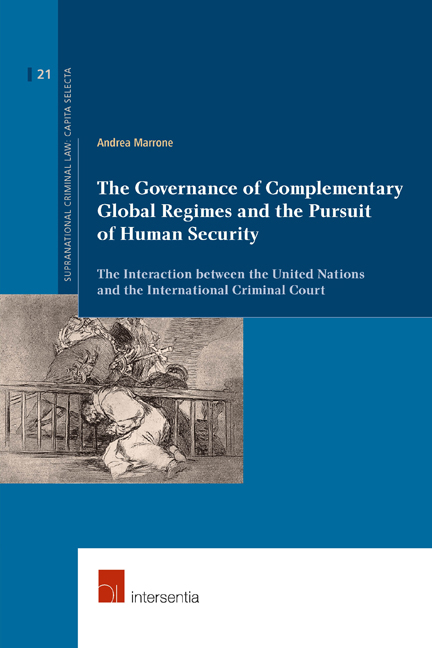 The Governance of Complementary Global Regimes and the Pursuit of Human Security
The Governance of Complementary Global Regimes and the Pursuit of Human Security from PART I - THE QUEST OF COMPLEMENTARITY AND THE DILEMMA OF HUMAN SECURITY
Published online by Cambridge University Press: 15 December 2017
PRELIMINARY REMARKS
This part explores the quest of complementarity trying to fix the margins between statehood, sovereignty and international governance of mass atrocity crimes and the pursuit of human security. It offers an overview of the tools at disposition by the international community in societies in transition from conflict to reconstruction offering reliable models of governance and based on the advocacy of human security. In this chapter the following topics have been comprehensively debated: the legal and political frameworks of governance fostering human security, the discussions around the rule of international law, the function of multilateralism versus unilateral interests, and the risk of opportunistic policy formulations. The last section concludes the assessment provided in the whole chapter about the transition of the concept of security and the paradigms in the making between the conceptualization, the applicability, and the critics of the human security doctrine. In other words, it highlights the formulation of human security systems of complementary character fighting against war and crime and the requirements thereof. The contribution in this debate underscores the needs of democratic governance of humanitarian affairs throughout institutional reforms, strengthening the partnerships and relationships of governance institutions of complementary character with measures of human security.
This chapter clarifies where the emerging regime of international criminal justice comes from, and where it should go within the arrays of the governance of international peace and security and its role in the maintenance and restoration of sustainable peace. The main assumption articulated in this chapter is that the architecture of global governance systems reflecting the world as it existed in 1945, has not kept pace with the fundamental changes taking place in the world community. We face an incredible amount of shortcomings in the governance systems fostering human security at national, regional and international levels. The paradigm shifts include the spread of global threats, the commission of serious crimes of common concern during violent political transitions, and the devastating consequences of intra-state armed conflicts. The military interventions for humanitarian reasons and the protection duties of civilians are inconsistent, while the interaction strategies to prevent mass atrocity crimes with timely intervention are not sufficient.
To save this book to your Kindle, first ensure [email protected] is added to your Approved Personal Document E-mail List under your Personal Document Settings on the Manage Your Content and Devices page of your Amazon account. Then enter the ‘name’ part of your Kindle email address below. Find out more about saving to your Kindle.
Note you can select to save to either the @free.kindle.com or @kindle.com variations. ‘@free.kindle.com’ emails are free but can only be saved to your device when it is connected to wi-fi. ‘@kindle.com’ emails can be delivered even when you are not connected to wi-fi, but note that service fees apply.
Find out more about the Kindle Personal Document Service.
To save content items to your account, please confirm that you agree to abide by our usage policies. If this is the first time you use this feature, you will be asked to authorise Cambridge Core to connect with your account. Find out more about saving content to Dropbox.
To save content items to your account, please confirm that you agree to abide by our usage policies. If this is the first time you use this feature, you will be asked to authorise Cambridge Core to connect with your account. Find out more about saving content to Google Drive.